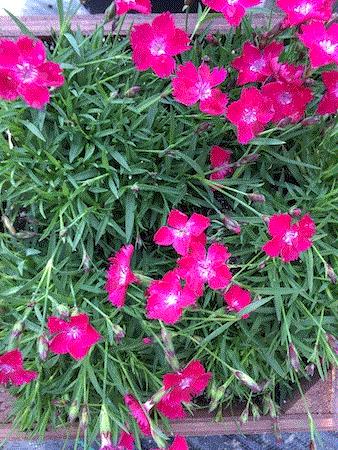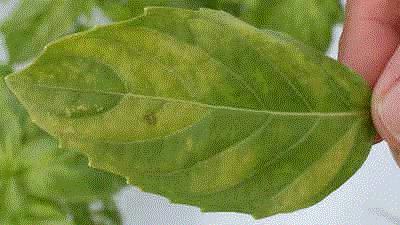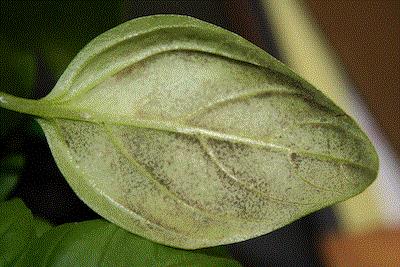What’s Happening Here?
I can’t think of any better way to start the last newsletter of the year than with a diagnostic challenge. Check out the leaf in the image below:

www.ag.umass.edu
I’d give you the name of the plant, but that would likely make this an incredibly easy challenge to solve. If you recognize the leaf, you’re already on the right track. What could possibly be causing this leaf to appear like this? Are you thinking it’s a nutritional disorder, disease, virus, phytotoxicity or something else? Take your time, enjoy the newsletter and I’ll ask you for your guess in a few minutes.
Unilateral Landscape Comments
In my last newsletter, Angela Treadwell-Palmer from Plants Nouveau shared an article with us about rumblings in the industry she’s heard regarding consumers driving a shift from compact to taller perennials in the landscape.
Here are a few comments I received about her article and the use of one-dimensional plants in the landscape.
- The perspective of a designer is critical in this business, and the chasm between garden/landscape design and other parts of the supply chain has been deepening but has never really been well connected. The industry will, as a whole, benefit greatly from broader respect for the positive effect of good design, or at least from an effort to avoid the effect of poor design that occurs ad-hoc as amateurs use plants they buy inspired by their appeal on the retail display.
- From the retailer perspective, freight is looked at as an expense to cut in order to keep retail prices low, rather than as a chance for greater revenue and margin. This is not correct, but it is what happens. Growers and IGC perennial buyers have adapted to this, and the process to get them to accept higher-priced taller plants may be more difficult due to their sensitivity to prices.
- There may have been a greater selection of taller plants to choose from in the past, but that was not because gardens and their designers needed them. It was because they happened to be available and were selected to execute design principles. Now maybe this can come around full circle—certainly, the dialogue will at least give us the feeling of hope.
- Another problem with all these dwarf plants, perennials in particular, is maintenance. Deadheading is a chore made worse by either bending way over for too long or kneeling for a long period of time and then trying to get up. Deadheading at waist level is a breeze.
Angela, thanks again for sharing this article with us!
Click HERE if you didn’t see the article or if you’d like a refresher on the topic.
(FYI: In the article last time, I inadvertently meshed the emails from two of my accounts together into a non-existent email; unfortunately that one is not functional, but ppilon@ballpublishing.com is and you can send your comments to me at this fully functional address.)

Perennials: A Billion-Dollar Industry
The U.S. Census of Horticultural Specialties conducted in 2014 reported the total sales for the potted herbaceous perennial plant category was $945 million at that time. I anticipate it’s above $1 billion dollars now. Am I right?

I had to go to my bank vault, but thought you'd like to see what $1 billion dollars looks like when $100 bills are stacked onto 12 pallets. Obviously, you can see I took a little for Christmas shopping, but I think you get the idea.
This is where you come in. The U.S. Department of Agriculture’s National Statistics Service (NASS) will be conducting the 2019 Census of Horticultural Specialties this winter. The results of this survey provides a comprehensive picture of the U.S. horticultural industry including floriculture, nursery, specialty crops and greenhouse food crops.
Over 40,000 horticultural producers will receive the survey this month. You are required by federal law as part of the Census of Agriculture program to respond. The responses are confidential. Participants are asked to complete the survey online via the NASS secure website.
You can learn more about the 2019 Census of Horticultural specialties by visiting https://www.nass.usda.gov/Surveys/Guide_to_NASS_Surveys/Census_of_Horticultural_Specialties/index.php .
The deadline is February 5, 2020. The results will be available in December 2020. Shortly thereafter, I’m hoping to officially announce the herbaceous perennial industry is indeed a $1 billion industry.

Award-Winning Dianthus
Dianthus Kahori Scarlet was recently chosen as a perennial top performer by Colorado State University. The "Top Performer" designation is only given to plants that have maintained superior performance in the ground, surviving for two winters and three growing seasons in the Flower Trial Garden.

Kahori Scarlet is very floriferous but does not produce scarlet flowers (at least to my eye); the blooms appear more of a hot rose. Regardless, Kahori Scarlet is a great, reliable and easy-to-grow first year flowering dianthus that fits most perennial programs. Hardy to Zone 3.
January Events
The new year offers many learning and networking opportunities for our industry. Here are several trade events I thought might be of interest to you. Click the name for event information.
January 6-7 The SNA Conference -Baltimore, Maryland
January 8-9 Montana Green Expo – Missoula, Montana
January 8-10 Mid-Atlantic Nursery Trade Show (MANTS) – Baltimore, Maryland
January 8-10 Landscape Ontario Congress – Toronto, Ontario
January 9-10 P.L.A.N.T.S. 2020 – Hot Springs, Arkansas
January 14-16 Northern Green – Minneapolis, Minnesota
January 15-17 The Western – Kansas City, Missouri
January 15-17 Idaho Horticulture Expo – Boise, Idaho
January 15-17 Gulf States Horticultural Expo – Mobile, Alabama
January 21-23 Wintergreen – Duluth, Georgia
January 21-22 InVigorateU – Normal, Illinois
January 22-23 CNLA Winter Symposium & Expo – Plantsville, Connecticut
January 23-25 NALP Leaders Forum – Los Cabos, Mexico
January 26-28 NDNGLA Convention – Fargo, North Dakota
January 27-29 Great Lakes Trade Expo – Lansing, Michigan
January 27-31 Green & Growin’ 20 – Greensboro, North Carolina
January 27-29 Utah Green Industry Conference & Trade Show – Sandy, Utah
January 28-31 IPM Essen – Essen, Germany
January 28-29 Total Pro Expo – Edison, New Jersey
January 29-30 iLandscape – Schaumburg, Illinois
If your schedule permits, I encourage you to attend one or moreof these trade events to enhance your knowledge and relationships. (For even more events, go to www.hortcalendar.com.)

The Answer Is …
At the top of the newsletter, I shared the image below and asked if you could properly diagnose the cause of this symptom:

www.ag.umass.edu
In this challenge, I opted to not provide any additional clues since I thought that would likely give away the answer. Have you narrowed down the possibilities? What if I told you the plant was basil? That’s what I thought: this clue either confirms your answer or greatly narrows it down for you.
Before I reveal the answer, here’s one more clue:

https://blog.extension.uconn.edu/
As we’ve discussed in previous challenges, it’s often helpful to look on the undersides of symptomatic leaves. Now that you've seen both sides of the leaf, I’m guessing most of you have correctly answered this week’s challenge. If you said downy mildew is the cause of the symptoms, congratulations! You correctly solved this week’s challenge. What a great way to end the year!
Preventing It from Occurring
Downy mildew (Peronospora belbahrii) is a fairly common disease on basil. The first indication of downy mildew is the yellow banding that occurs on the upper leaf surfaces. It’s most commonly observed between the veins. Turning the leaves over and seeing dark, sooty looking sporangia on the undersides confirms downy mildew is the culprit.
Infection begins with moist conditions and high humidity. A film of water on the leaves for more than six hours is sufficient for spore germination and entry into the plants. To reduce the likelihood of downy mildew infestations, maintain plants with dry leaves going into the night, increase the air circulation around the crop and irrigate early in the day rather than late, to allow the leaves to dry as quickly as possible.
Being an edible food crop, there are fewer options for preventing downy mildew with fungicides. There are numerous highly effective fungicides, but most of them are not labeled for applications to basil. Phosphorous acid fungicides such as ProPhyt, Fosphite and K-Phite are highly effective and list controlling downy mildew on herbs on their labels. Micora is another excellent option that has a supplemental label for use on basil. Always check fungicide labels to confirm they can be applied to basil before making fungicide applications. Ball Seed developed a very nice cultural guide that includes a downy mildew program. Click HERE to download this guide.



Thanks for reading this edition of Perennial Pulse. Enjoy the holiday season!
My email is ppilon@ballpublishing.com.
Take care, and see you in 2020!
Paul Pilon
Editor-at-Large
Perennial Pulse
This email was received by you and 30,352 other fine subscribers!
If you're interested in advertising in Perennial Pulse, contact Kim Brown ASAP and she'll hook you up.